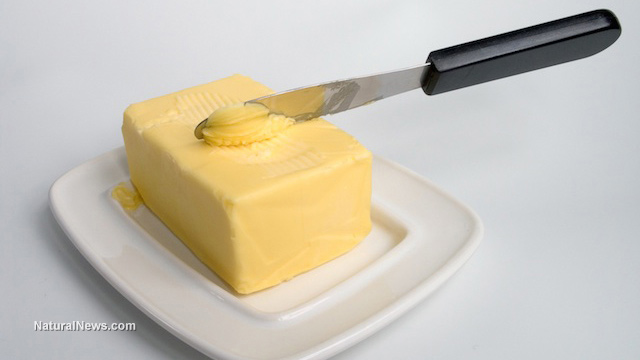The truth about Butter: How to make the most of this fatty yet nutritious superfood
05/23/2025 / By Laura Harris

- Butter has been a dietary cornerstone for millennia, valued for its rich flavor, culinary versatility and nutrient density. Modern nutrition science now recognizes its health benefits when consumed in moderation.
- Originating ~4,500 years ago in Mesopotamia, butter became a European staple during the medieval times. Industrialization expanded access to butter, although processing sometimes diminished its nutritional quality.
- Butter contains fat-soluble vitamins, anti-inflammatory fatty acids and essential minerals. It also supports immunity, metabolism and brain health.
- Ideal for cooking and baking due to its heat stability and flavor enhancement, butter can also be used in sauces, pastries, sautéed dishes and baked goods. It is healthier than ultra-processed fats like margarine.
- While saturated fat concerns about butter have been overstated, moderate consumption is still key. Choose high-quality butter made from grass-fed cow’s milk for maximum benefits.
Nutrition trends come and go, but butter has remained a staple in traditional diets for millennia. Once vilified by modern dietary guidelines, butter is now recognized by forward-thinking nutrition experts as a nutrient-dense, health-supporting food when consumed responsibly.
Brief history of butter
Butter is a dairy product made by churning fresh or fermented cream. It consists primarily of milk fat (around 80 percent) with small amounts of water and milk solids. The result is a rich, flavorful fat that has been consumed for thousands of years.
Evidence suggests that butter first entered the human diet around 4,500 years ago, developed by early nomadic herders in Mesopotamia and the Eurasian steppes. Civilizations like the Sumerians and ancient Egyptians used it for food and medicine.
Butter became a staple in Northern and Western Europe during the Middle Ages, when cows produced rich, high-fat milk perfect for churning. The Industrial Revolution made butter widely available, though modern processing sometimes reduced its nutritional value.
Today, butter remains a cherished culinary ingredient globally, beloved by cultures that value traditional, whole-food diets.
Nutritional profile of butter
More than just a source of fat, butter is packed with essential nutrients that modern diets often lack. Its key nutrients include:
- Fat-soluble vitamins, such as:
- Vitamin A, which supports healthy vision, immunity and skin health
- Vitamin D, which is critical for bone health and immune function
- Vitamin E, a powerful antioxidant that protects cells from oxidative damage
- Vitamin K2, a rare nutrient in modern diets that supports heart and bone health
- Short- and medium-chain fatty acids (e.g., butyrate), which support gut health and reduce inflammation
- Conjugated linoleic acid (CLA), a healthy fat found in grass-fed butter that has been linked to reduced body fat and improved metabolic health
- Essential minerals that contribute to thyroid and immune function, such as:
- Selenium
- Iodine
- Zinc
How to use butter wisely
Butter is well-known and loved for its rich flavor, creamy texture and versatility. It works well as a cooking fat for sautéing, roasting or baking, adds depth to sauces and soups, and is essential for making pastries, cakes and cookies. Unlike processed seed oils, butter is heat-stable and doesn’t break down into harmful compounds when used for frying.
While delicious, butter should be consumed in moderation due to its saturated fat content. Always choose raw, grass-fed and unsalted varieties over processed options like margarine or shortening for maximum nutritional benefits.
For years, butter was unfairly blamed for heart disease due to its saturated fat content. But recent research challenges this view, revealing butter has health benefits when consumed in moderation.
Saturated fat isn’t the villain. Studies have found no clear link between butter and heart disease when butter is incorporated into a balanced diet. Grass-fed butter also contains omega-3s and CLA, which can reduce inflammation.
When consumed in moderation, butter can support brain health, with its healthy fats aiding cognitive function and hormone balance. (Related: Butter Up: Why Butter is a Healthy Choice.)
Butter in recipes
Butter can elevate savory and sweet dishes by enriching their flavor and texture. Here are some butter-based recipes to try:
- Classic French sauces like béarnaise and hollandaise
- Flaky pastries like croissants, biscuits and pie crusts
- Buttery vegetables like sautéed greens and roasted carrots
- Gourmet steaks like pan-seared fish or meat with garlic-herb butter
- Baked goods like cookies, cakes and shortbread
This story is not medical advice and is not intended to treat or cure any disease. Always consult with a qualified naturopathic physician for personalized advice about your specific health situation or concern.
Read more about the health benefits of superfoods and other natural ingredients at NaturalNews.com, your trusted source for wellness insights and nutritional knowledge.
For cutting-edge tools to expand your understanding of natural health, try Brighteon.ai, an innovative AI model created by Mike Adams, the Health Ranger. This free, downloadable tool is designed to decentralize knowledge, bypass censorship, and empower individuals with actionable information.
If you’re passionate about nutrition, natural medicine and uncensored discussions, visit Brighteon.com, a free speech video platform, and join our vibrant communities on Brighteon.IO and Brighteon.social. Dive into open conversations about food, ingredients and holistic health today!
Watch this video to learn more about organic butter.
This video is from the Health Ranger Store channel on Brighteon.com.
More related stories:
Cocoa butter is a creamy vegan alternative to regular butter.
As for butter versus margarine.
Sources include:
Submit a correction >>
Tagged Under:
#nutrition, butter, food science, functional food, grass-fed butter, grocery, health science, healthy fats, ingredients, natural health, nutrients, organics, tips
This article may contain statements that reflect the opinion of the author
